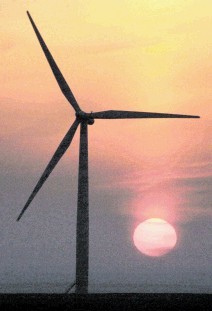
Wind power could supply up to 12% of global electricity by 2020, creating 1.4million new jobs and reducing CO2 emissions by more than 1.5billion tons per year, more than 5 times today’s level, according to new research.
And by 2030, wind power could provide more than 20% of global electricity supply, the Global Wind Energy Council and pressure group Greenpeace claim.
The fourth annual Global Wind Energy Outlook paints a picture of three different futures for the wind industry, looking at scenarios out to 2020, 2030, and eventually to 2050.
It then measures these scenarios against two different projections for the development of electricity demand: the first based on the International Energy Agency’s World Energy Outlook, and another, more energy efficient future developed by the ECOFYS consultancy and researchers at the University of Utrecht.
“It is clear that wind energy is going to play a major role in our energy future”, said Steve Sawyer, secretary general of the Global Wind Energy Council. “But for wind to reach its full potential, governments need to act quickly to address the climate crisis, while there’s still time.”
In addition to being a major source of emission reductions, wind energy also uses no fresh water to generate electricity, which makes it an attractive option in an increasingly water-constrained world.
Wind power is by definition an indigenous energy source, which is particularly useful to countries burdened with large fossil fuel import bills (increasingly the case for the UK).
GWEC and Greenpeace say that wind power is now competitive in an increasing number of markets, even when competing against heavily subsidised “conventional” energy sources, with little or no financial compensation for its environmental and social benefits: zero CO2 emissions, zero water use, and no air or water pollution.
“The most important ingredient for the long-term success of the wind industry is a stable, long-term policy, sending a clear signal to investors about the government’s vision for the scope and potential for the technology”, said Sven Teske, Greenpeace senior energy expert at the report’s launch in Beijing.
“The Global Wind Energy Outlook shows that the industry could employ 2.1million people by 2020 – three times more than today, given the right policy support.”
Wind energy installations totalled 240GW (gigawatts) globally by the end of 2011, and the industry is set to grow by at least another 40GW in 2012, according to the latest forecast and despite the ongoing financial crises of Europe and the US.
By 2020, the IEA’s New Policies Scenario suggests that total capacity would reach 587GW, supplying about 6% of global electricity; but the GWEO Moderate scenario suggests that this could reach 759GW, supplying 7.7-8.3% of global electricity supply.
The Advanced scenario suggests that with the right policy support wind power could reach more than 1,100GW by 2020, supplying between 11.7-12.6% of global electricity, and saving nearly 1.7billion tons of CO2 emissions.
Recommended for you
